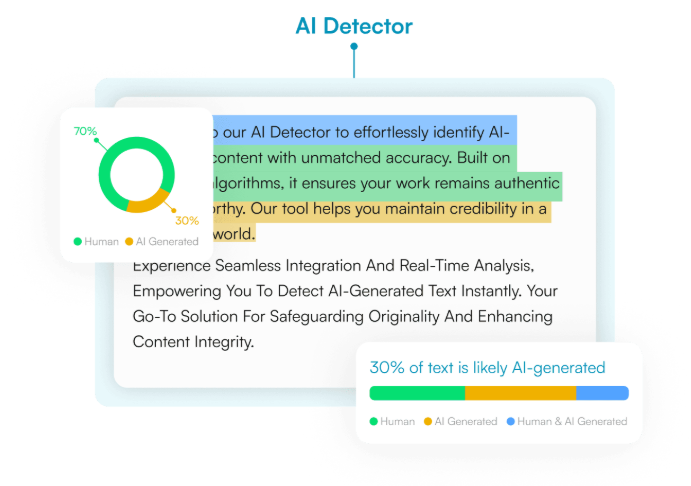Introduction
As artificial intelligence (AI) continues to revolutionize industries, it brings both extraordinary potential and unique challenges. One such challenge is the ability to distinguish between human-created and AI-generated content. This has led to the increasing development and use of a powerful tool known as the Detector de IA.
El Detector de IA es un sistema o algoritmo especializado diseñado para examinar y valorar si un elemento de contenido fue producido por un modelo de Inteligencia Artificial o por un ser humano. With the rise of large language models like ChatGPT, GPT-4, Bard, and others, these detectors are becoming indispensable in educational institutions, publishing, journalism, recruitment, and digital marketing.
Why the Need for AI Detection?
The rapid proliferation of AI-generated text, images, and videos has made it difficult to identify the origin of content. Students can now complete assignments using AI. Fake news can be auto-generated in seconds.Los candidatos a puestos laborales pueden utilizar recursos de Inteligencia Artificial para redactar currículums o responder a preguntas de entrevista.n such an environment, AI detection tools are critical for maintaining authenticity, trust, and fairness.
Imagine a university trying to ensure academic integrity or a news agency verifying the legitimacy of a breaking story — a reliable Detector de IA is essential in such cases.
How a Detector de IA Works
A Detector de IA typically uses a combination of natural language processing (NLP), statistical analysis, and machine learning to assess patterns within the content. Here’s how it generally works:
- Linguistic Patterns: AI-generated content often lacks the complexity, subtlety, or emotional variation that human writing exhibits. Detectors examine these discrepancies.
- Repetitive Structures: AI may overuse specific words or phrases, or maintain uniform sentence lengths.
- Perplexity and Burstiness: These are statistical measurements. Human writing usually has higher perplexity (less predictable) and more burstiness (variation in sentence length), whereas AI writing tends to be more uniform.
- Source Comparison: Some tools compare the input with existing AI-generated content from known models.
In short, a Detector de IA doesn’t just rely on grammar—it dives deep into the DNA of the writing style.
Popular AI Detection Tools in 2025
The growing demand has given rise to many AI detectors. Here are some of the most popular tools in the market:
- OpenAI AI Text Classifier – Desarrollado por OpenAI para identificar contenido producido por sus propios modelos.
- GPTZero – Initially popular in academic settings for identifying AI-written essays.
- Writer.com’s AI Content Detector – Used widely by digital marketers.
- Copyleaks AI Content Detector – Known for supporting multiple languages.
- Turnitin AI Detection – A favorite in educational institutions for identifying plagiarism and AI use.
Each of these tools uses a slightly different algorithm, but the goal remains the same: to maintain authenticity in a digital world increasingly shaped by AI.
See more related article detecteur ia
Applications of Detector de IA
1. Academia:
Schools and universities are using AI detectors to ensure students don’t submit AI-generated essays or reports. It’s about preserving the value of education and original thinking.
2. Journalism:
News organizations use these tools to confirm that stories are written by real journalistsEn una era de deepfakes y falsedades, este aspecto es crucial.
3. Recruitment:
Employers now check resumes, cover letters, and even online assessments for AI involvement. They want to know who the real candidate is.
4. Content Creation & SEO:
Marketing agencies use a Detector de IA to ensure the content remains human-centric for SEO ranking purposes. Google prefers content written with genuine intent.
5. Legal and Regulatory Compliance:
AI detection ensures compliance with publishing laws, copyright guidelines, and ethical standards, particularly in sensitive areas like finance and healthcare.
Challenges and Limitations
No Detector de IA is perfect. While they are getting better, these systems have limitations:
- False Positives: Sometimes, human-written content is flagged as AI-generated, especially if it’s formal or lacks emotion.
- False Negatives: Advanced AI models can mimic human writing well enough to evade detection.
- Evolving AI Models: As AI continues to improve, detectors must keep pace with increasingly sophisticated outputs.
This arms race between content generators and detectors means that continuous updates and advancements are essential.
Ethical Considerations
As with any technology, the use of Detector de IA tools raises ethical questions:
- Privacy: Scanning personal documents or communications could infringe on individual rights.
- Bias: Some detection algorithms might unfairly target certain writing styles or linguistic backgrounds.
- Overreliance: Relying too heavily on detectors might punish honest individuals or discourage creative expression.
The Future of Detector de IA
- Multimodal Detection: Future detectors might analyze not just text, but also images, voice, and video.
- Integration with Platforms: Expect to see AI detection integrated directly into learning management systems, publishing software, and even email platforms.
- Blockchain Verification: Digital signatures or blockchain might be used to authenticate original human content.
- Real-time Detection: Instant detection as content is created or edited could become the new norm.
The Detector de IA will evolve into a guardian of digital integrity — becoming as essential as antivirus software is today.
Conclusion: A Tool for Truth in the AI Era
In a world where AI is transforming everything from education to business to entertainment, the Detector de IA stands as a crucial tool for ensuring honesty, originality, and trust. While it is not without limitations, its importance will only grow in the coming years.




